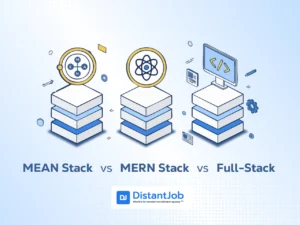Choosing React Native vs Pure Native development is a crucial decision when developing for mobile. The bottom line is that you have to choose between cross-platform and performance.
On one side, there is React Native, a cross-platform framework that allows you to write a whole app using JavaScript and access both iOS and Android markets. Conversely, you have pure native development that uses platform-specific languages like Swift for iOS and Kotlin/Java for Android. But just one of them will exceed expectations in performance. For example, Pure Native uses less CPU, while React Native uses more processing power, especially on iOS (151% vs 72%).
For better performance, you can either pick between iOS and Android and stick with it, or spend more money hiring two developer teams, making development longer and more expensive.
Our goal today is to examine both approaches and pinpoint the most effective one for your mobile app development.
What is React Native?
React Native is an open-source framework developed by Facebook Inc. (Meta nowadays) for building native mobile apps using JavaScript/TypeScript. It allows developers to create apps for multiple platforms, including Android, iOS, macOS, tvOS, UWP, Web, and Windows using a single codebase.
JavaScript is the most popular programming language in the world, so it’s easier to find developers for React Native. It gives a mobile application a universal reach for mobile platforms.
Pros and Cons
React Native gives you access to multiple mobile platforms quickly and affordably using JavaScript, but you’ll face limitations with native APIs and may need third-party solutions for specific integrations.
Pros:
- Cross-platform development: Write code only once and share it between iOS, Android, and any other mobile platform. It reduces development time and costs.
- Faster development: JavaScript is generally easier to learn and faster to code in than platform-specific languages like Swift or Kotlin.
- Large community and abundant resources: React Native has a large and active community, leading to readily available libraries, tools, and support.
- Hot reloading: Quick updates and feedback during development.
Cons:
- Performance limitations: It may or may not achieve the same level of performance as native apps, especially for complex or computationally intensive tasks. As the app gets cruder, the better the performance.
- Reliance on third-party libraries: The app may require more third-party libraries and APIs compared to native development, potentially increasing complexity and points of failure.
- Less smooth navigation: Navigation and transitions might not be as smooth as in native apps.
What is Pure Native app development?
Pure Native refers to creating applications with their native tools: Swift and/or Objective-C on IDE Xcode for iOS and Kotlin and/or Java on Android Studio for Android.
Pure native development lets you use the best tools for each platform, resulting in better performance and user experience. The downside? You’ll need separate development teams and budgets for iOS and Android, making it more expensive and time-consuming.
Pros and Cons
Pure native development is the best choice when your app needs top performance and deep integration with platform-specific APIs. Everything works seamlessly, from new platform services to smooth navigation. That’s why AAA game developers always choose native development.
But native becomes a problem for simpler apps. If you’re building a basic CRUD application that needs to reach as many users as possible, native development creates unnecessary obstacles.
Pros:
- Peak Performance: Best performance and responsiveness as it utilizes platform-specific languages and APIs.
- Smoother and responsive UI: Better performance goes hand in hand with a more interactive UI when design is a priority.
- New features access: Complete access to device hardware and software features, including native APIs and the latest SDKs.
- Security: Native apps are safer and independent of third-party software to communicate with the operating system.
- Mature ecosystem: A well-established ecosystem of tools, libraries, and community support at your disposal.
Cons:
- Higher development costs: Requires separate codebases for iOS and Android, maybe even teams, which increases development time and costs.
- Steeper learning curve: Expertise in platform-specific languages and frameworks (Swift/Objective-C for iOS, Java/Kotlin for Android) is harder to find than JavaScript expertise. They are also harder to learn.
- Slower development cycles: Developing for both platforms simultaneously takes longer compared to using a cross-platform framework like React Native. It also makes the app slower to market.
React Native vs Pure Native: Technical Comparison
While comparing React Native vs Pure Native, native development wins the performance battle with faster startup times, lower CPU usage, and better memory management, especially for games and animation-heavy apps that need direct hardware access.
But React Native offers a smart trade-off. You get faster development, lower costs, and reusable code across platforms. This makes React Native perfect for feature-rich apps that need to launch quickly and reach both iOS and Android users without breaking the budget.
The choice comes down to priorities: choose pure native for maximum performance, or React Native for speed and cost efficiency.
Development Speed and Cost Efficiency
Startups prefer React Native because of its development and cost efficiency. When one natively develops an app that works on both iPhones (iOS) and Android, it usually takes twice the work: two different teams of developers, one for each type of phone, and they have to build the app separately for each.
Even after the app is launched, fixing problems or adding new features means doing it twice, which also costs more. Native development for multi-platforms is expensive.
However, with React Native, one team can build the app for both iPhones and Android phones at the same time. There is no need for multiple developer teams, and there is a single app that works on every mobile platform.
Discord cut its costs by 30% by using React Native. Binmile estimates a cost savings of 30%-35% and a development speed from 40% to 90%; Brilworks suggests cost savings from 40% to 50%.
Performance and User Experience
Native apps consistently outperform React Native in key performance areas. They deliver faster startup times, smoother animations, better memory management, and superior CPU efficiency, making them ideal for complex, high-performance applications that need full access to device features and OS capabilities.
React Native offers good performance for most business applications but comes with trade-offs. While it aims for near-native performance, React Native apps typically have slower startup times and may experience UI lag with complex animations or heavy graphics due to the JavaScript bridge, the API layer that translates JavaScript code into native code. Despite these limitations, React Native performs well enough for standard app functionality and typical business use cases. We will address it in the benchmarks section.
Maintenance
React Native’s single codebase is a maintenance game-changer. When you fix a bug or add a feature, the changes automatically apply to both iOS and Android platforms. This unified approach dramatically cuts ongoing maintenance costs compared to managing two separate native codebases.
The cost savings add up quickly. You need fewer developers on your team and spend significantly less time on updates since everything happens once instead of twice. For businesses focused on long-term budget efficiency, React Native delivers the best return on investment for cross-platform development.
The key differences between React Native and pure native development:
- Development speed: React Native allows faster development with one codebase; pure native requires separate codebases
- Performance: Pure native apps deliver superior performance; React Native apps may have slight performance limitations
- Cost: React Native reduces development costs with shared code; pure native requires separate development teams
- User experience: Pure native provides platform-optimized UI; React Native offers a good but not perfect native feel
- Maintenance: React Native enables easier updates across platforms; pure native requires platform-specific maintenance
| Feature | React Native | Pure Native |
| Development Speed | Faster development with one codebase in JavaScript Hot reloading provides quick updates | Slower development cycles Requires separate codebases for iOS and Android Slower Development |
| Costs | Reduces development costs with shared code Needs just one team | Higher development costs If cross-platforming: It requires separate codebases Needs more than one team. Fixing problems or adding new features costs at least twice as much |
| Performance | Depends on the complexity of the project Minor performance overhead due to JavaScript bridge | Delivers superior performance, responsiveness, and UX. Utilizes platform-specific languages and APIs. Ideal for complex, high-performance, or graphically intensive apps, like games |
| User Experience (UX) | Good enough Navigation and transitions might not be as smooth as in native apps | Platform-optimized UI Smoother and more responsive UI. Full access to device hardware and software features |
| Maintenance | Easier and more cost-effective (due to a single codebase) Fixing a bug or adding a new feature brings change to all platforms Reduced ongoing costs Fewer hours spent and fewer developers needed | Requires platform-specific maintenance Separate codebases for iOS and Android Bug fixes and new features implemented independently Increased effort and cost (time and budget) More developers |
Ultimately, the choice between React Native and native app development depends on your project’s specific needs, budget, desired time-to-market, and the complexity and performance requirements of the application.
React Native vs Pure Native Benchmark
To put some concrete numbers to the performance discussion, let’s look at a few benchmark metrics comparing React Native and pure native apps. Pure native apps run smoother and use less memory, while React Native apps work fine for most users but struggle under heavy load. Real-world testing shows how React Native and pure native apps actually perform:
Startup Speed:
- Both take the same time to launch (4 seconds on Android, 10 seconds on iOS)
CPU Usage:
- React Native uses more processing power, especially on iOS (151% vs 72%)
- Android shows smaller differences (15.6 vs 18.9)
Frame Rate:
- React Native: ~58 FPS (drops during heavy use)
- Pure Native: 60 FPS (stays consistent)
Memory Usage:
- React Native uses significantly more RAM
- Android: 280 MB vs 205 MB
When to choose React Native
Choose React Native for faster development, cost efficiency, and cross-platform reach, suitable for most standard business applications where near-native performance is sufficient.
When to Choose Pure Native
Choose Native development for peak performance, device integration, and highly complex or graphically intensive applications. You can develop an app for each mobile platform only if you have the budget and time.
Conclusion
The decision between React Native and pure native comes down to your priorities: speed and cost versus performance and optimization. For most startups and businesses, React Native offers the best balance of speed, cost, and reach. For performance-critical applications, pure native development delivers superior results but requires more time and investment.
React Native gets you to market faster and cheaper, while pure native gives you maximum performance and platform-specific optimization. Choose based on what matters most to your project’s success. And if you need a JavaScript developer or are solely in need of hiring a React Native expert, feel free to reach out. We have been in the business of headhunting senior developers for more than 2 decades now.





